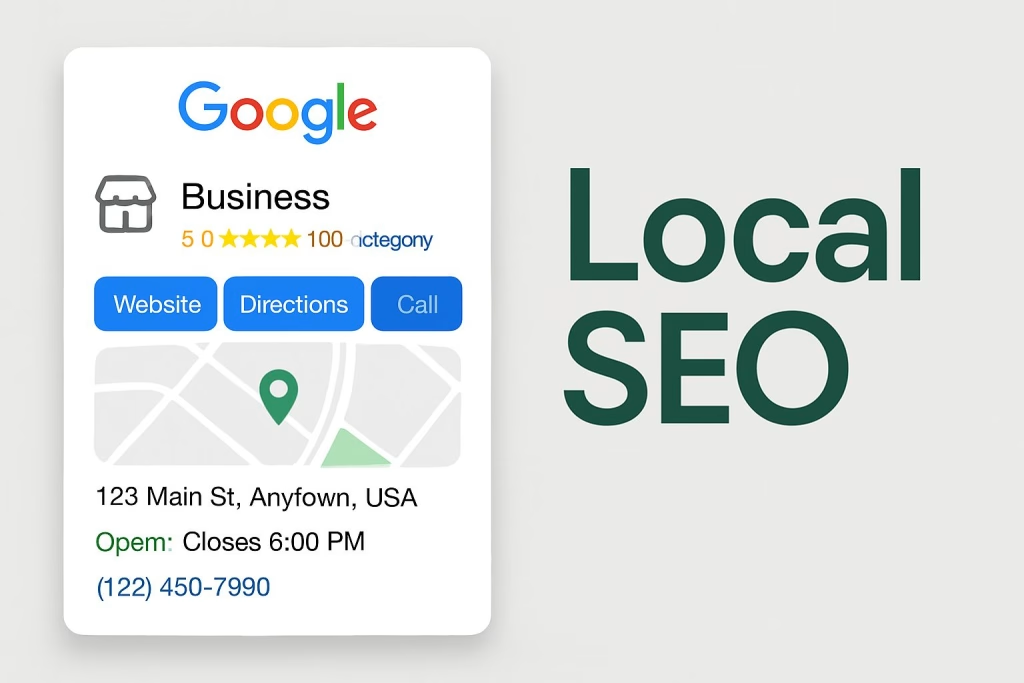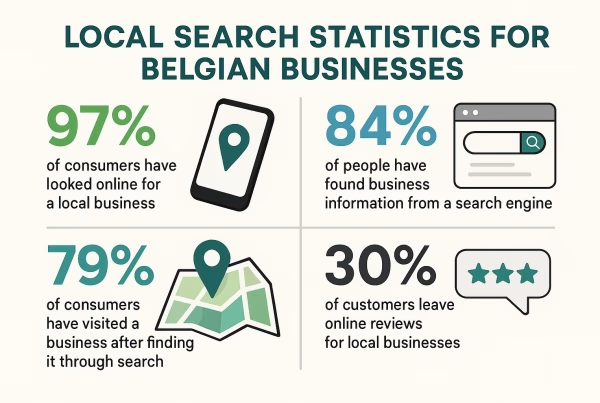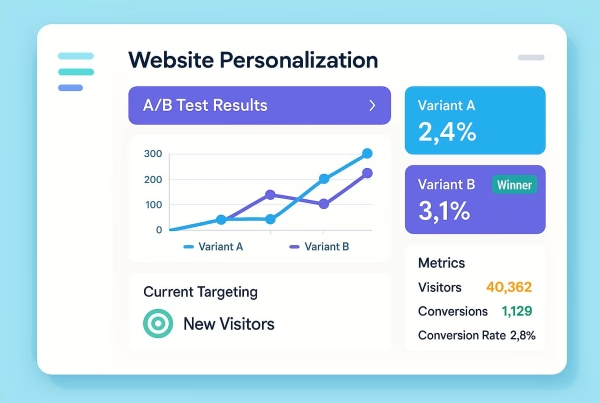Last week I spoke with Peter, owner of a successful bakery in Ghent. He told me something remarkable: “Since I tackled my local SEO in Belgium, I get three times as many customers through Google. People now find me even when they just search for ‘fresh croissants’.”
I hear this story more and more from Flemish entrepreneurs. Local SEO is no longer a luxury – it has become a necessity for businesses that want to survive in the digital economy.
Why local SEO is so powerful for Flemish businesses
The numbers don’t lie. According to Google, 46% of all users search for local information, and 78% of local mobile searches result in an offline purchase. For Flemish cities like Antwerp, Ghent, and Bruges, this means enormous opportunities.
But here’s where it gets interesting: most local businesses do local SEO completely wrong. They focus on big, competitive keywords while their potential customers search much more specifically. Someone typing “restaurant Antwerp center” is much more valuable than someone just searching “restaurant.”
The 7 strategies that make the difference
In this guide, I share the exact strategies that Flemish businesses use to drastically improve their local visibility. From Google My Business optimization to hyperlocal content creation – every tactic is tested and proven in the Belgian market.
Whether you run a restaurant in Leuven, have a hair salon in Hasselt, or offer services in Kortrijk – these strategies work. Research by BrightLocal shows that businesses taking local SEO seriously have on average 300% more online visibility.
Let’s start with the first strategy you can implement today.
Why Local SEO Is Crucial for Flemish Entrepreneurs

Last week I got a call from Sarah, owner of a flower shop in Mechelen. She was frustrated because her competitor – a much smaller business – kept ranking higher in Google. It turned out her competitor was smartly using local SEO, while Sarah still thought a beautiful website was enough.
Local SEO is fundamentally different from traditional SEO. It’s about proximity, relevance, and prominence within a specific geographic zone. For Flemish businesses, this means you don’t have to compete with all of Belgium – you only compete with businesses in your area.
3 Statistics Every Belgian Entrepreneur Must Know
The impact of local SEO on Flemish businesses is staggering:
- 97% of consumers search online for local businesses, especially on mobile devices
- 88% of local searches on mobile result in a phone call or visit within 24 hours
- 50% of consumers who perform a local search visit the store that same day
These numbers mean that every day you neglect local SEO, you’re literally leaving money on the table. A well-optimized local business can easily bring in 5-10 new customers per week through Google.
The Difference Between National and Local Searches
National SEO revolves around keywords like “best restaurant” or “cheap shoes.” Local SEO focuses on “best restaurant Antwerp” or “shoe store Ghent center.”
The difference? Intent. Someone searching “dentist Bruges” wants to make an appointment today. Someone just searching “dentist” might just be looking around.
Local searches have a much higher conversion rate because the searcher already knows what they want and where they want to find it.
Strategy 1 – Fully Optimize Google Bussiness
Google My Business (GMB) is the cornerstone of local SEO. It’s your digital business card that appears when people search for your type of business. Yet I see that 80% of Flemish businesses poorly maintain their GMB profile.
Last month I helped an electrician from Hasselt optimize his GMB. Within 3 weeks, his number of phone calls increased from 2 to 15 per week. Here’s how he did it:
Step 1: Claim and verify your profile Start by claiming your Google My Business profile. Many businesses already exist in Google’s database but aren’t claimed. Go to business.google.com and search for your business.
Step 2: Fill in all fields Don’t leave any field empty. Add your opening hours, phone number, website, and a detailed description. Google rewards complete profiles with better rankings.
Step 3: Choose the right categories Select one primary category that best describes your business, and add 4-5 secondary categories. For a restaurant in Leuven, you might choose “Restaurant” as primary category and “Belgian restaurant,” “European restaurant,” and “Cafe” as secondary.
Step 4: Add high-quality photos Upload at least 10 photos: exterior, interior, products, and team. Businesses with photos get 42% more requests for directions and 35% more clicks to their website.
Step 5: Post regular updates Use the GMB Posts feature to share news, offers, and events. Posts remain visible for 7 days and help keep your profile active.
4 Often Forgotten GMB Features That Increase Conversions
Most businesses only use basic GMB features, but there are powerful functions they miss:
- Q&A section: Proactively answer frequently asked questions
- Products/Services: Add detailed descriptions and prices
- Booking button: Integrate online appointments directly into your profile
- Messaging: Let customers send messages directly through your GMB
Photos and Posts: 6 Best Practices for More Engagement
- Upload new photos weekly – Google rewards fresh content
- Use photos of real customers – authentic images work better
- Add text overlay to photos – increase informational value
- Post offers with end dates – create urgency
- Share behind-the-scenes content – build trust
- Tag your location in photos – strengthen your geographic relevance
Strategy 2 – Systematically Build Local Citations
Citations are online mentions of your business name, address, and phone number (NAP). They function as digital references that help Google trust and position your business.
I discovered the importance of citations when working with a barber from Kortrijk. He had a beautiful website and active social media, but ranked poorly locally. After building 25 quality citations, he rose from page 3 to position 2 in local search results.
15 Belgian Directories That Google Trusts
Not all directories are equal. Focus on these Belgian platforms that Google considers authoritative:
General directories:
- Gouden Gids (pagesdor.be)
- Vlan.be
- 2dehands.be (for retailers)
- Editus.be
- Infobel.com
Industry-specific directories: 6. TripAdvisor (restaurants/hotels) 7. Foursquare 8. Yelp 9. Facebook Business 10. Kompass Belgium
Local directories: 11. City-specific websites (antwerpen.be, gent.be, etc.) 12. Local newspaper websites 13. Chamber of Commerce listings 14. Local bloggers and influencers 15. Industry organizations
Building citations requires patience. Plan 2-3 submissions per week over 3 months. Quality over quantity – one citation on an authority site is worth more than 10 on spam sites.
NAP Consistency: 3 Tools for Error-Free Data
NAP inconsistency is one of the biggest local SEO killers. If your business name is “Jan’s Cafe” on one site and “Cafe Jan” on another, you confuse Google.
Tool 1: Moz Local Check Free tool that checks your NAP consistency across 15+ directories. Shows exactly where inconsistencies occur.
Tool 2: BrightLocal Citation Tracker Paid tool that monitors 100+ directories and automatically detects inconsistencies.
Tool 3: Whitespark Local Citation Finder Helps find new citation opportunities specific to your industry and location.
Strategy 3 – Implement Schema Markup
Schema markup is structured data that helps Google better understand your content. For local businesses, it’s like a translator that tells Google exactly what you do, where you’re located, and when you’re open.
A restaurant owner in Bruges implemented schema markup and saw his rich snippets appear within 2 weeks. His click-through rate increased by 34% because his search result now showed opening hours, ratings, and price range.
4 Schema Types Every Local Website Needs
1. LocalBusiness Schema The most important schema type. Contains your NAP, opening hours, and contact information.
json{
"@context": "https://schema.org",
"@type": "LocalBusiness",
"name": "Cafe De Vriendschap",
"address": {
"@type": "PostalAddress",
"streetAddress": "Grote Markt 15",
"addressLocality": "Ghent",
"postalCode": "9000",
"addressCountry": "BE"
},
"telephone": "+32 9 123 4567"
}
2. Review Schema Shows star ratings in search results, which dramatically increases click-through rate.
3. Event Schema For businesses that organize events. Helps events appear in Google Events and local search results.
4. FAQ Schema Shows frequently asked questions directly in search results, taking up more space and radiating authority.
Implementation in 3 Simple Steps
Step 1: Generate your schema code Use Google’s Structured Data Markup Helper or schema.org generators to create your code.
Step 2: Add code to your website Place the JSON-LD code in the <head> section of your HTML, or use WordPress plugins like Yoast SEO.
Step 3: Test and validate Use Google’s Rich Results Test to check if your schema is correctly implemented.
Strategy 4 – Create Hyperlocal Content That Converts
Hyperlocal content goes deeper than “best restaurant Ghent.” It targets specific neighborhoods, streets, and local events. This content shows Google that you’re truly part of the local community.
A real estate agent from Antwerp started writing neighborhood guides for every area where he was active. “The Ultimate Guide to Living in Zurenborg” and “7 Reasons Why Het Eilandje Is Perfect for Starters” became his best-performing pages. They brought him 40% more local leads within 6 months.
8 Content Ideas for Every Flemish City
- Neighborhood guides: “Living in [Neighborhood]: Complete Guide for Newcomers”
- Local events: “5 Must-See Events in [City] This Month”
- Historical content: “The Hidden History of [Street/Square]”
- Local partnerships: “Why We Partner With [Local Business]”
- Seasonal content: “Winter Activities in [City]: 10 Insider Tips”
- Local issues: “Parking in [Center]: 7 Secret Spots”
- Community spotlights: “Meet [Local Entrepreneur]: An Inspiring Story”
- Local comparisons: “[City] vs [City]: Where Should You Live?”
Local Keywords Research: 5 Advanced Techniques
Technique 1: Google Autocomplete Mining Type your service + city in Google and note all autocomplete suggestions. “Barber Ghent” gives suggestions like “barber Ghent center,” “barber Ghent open Sunday.”
Technique 2: Competitor Analysis Analyze which local keywords your competitors use with tools like SEMrush or Ahrefs local data.
Technique 3: Google My Business Insights Check which search terms customers use to find your GMB profile. This data is gold.
Technique 4: Local Forums and Facebook Groups Monitor how people talk about your services in local Facebook groups. Real language from real customers.
Technique 5: “Near Me” Variations Optimize for “near me” searches: “barber near me,” “restaurant near me.” These have explosive growth.
Strategy 5 – Strategically Manage Online Reputation
Online reviews are the new word-of-mouth marketing. 93% of consumers read reviews before visiting a local business, and businesses with 4+ stars get 5x more clicks than businesses with less than 3 stars.
I worked with a dental practice in Leuven that only had 6 reviews (all 5 stars, but too few to trust). We implemented a systematic review strategy and within 4 months they had 47 reviews with a 4.8 average. Their new patients increased by 180%.
6 Ways to Get More Positive Reviews
1. The 24-hour rule Ask for reviews within 24 hours of a positive experience. Customers are still enthusiastic and more willing to help.
2. Make it easy Send direct links to your Google, Facebook, or industry-specific review platforms. Every extra click reduces your response rate.
3. Use email automation Set up automated emails sent 2-3 days after purchase/service with a friendly request for feedback.
4. Reward reviewers (carefully) Offer small rewards like discount codes or free add-ons, but never mention it’s for a review (this violates platform policies).
5. Train your staff Every team member should know how and when to ask for reviews. Make it part of your standard service procedure.
6. Use review QR codes Place QR codes on receipts, tables, or in your store that lead directly to your review page.
Turn Negative Reviews Into Opportunities in 4 Steps
Negative reviews aren’t disasters – they’re opportunities to show your excellent customer service. Potential customers read how you handle problems.
Step 1: Respond quickly (within 24 hours) Quick responses show you take customers seriously and actively manage your online presence.
Step 2: Take responsibility Even if the customer is wrong, acknowledge their frustration and show empathy.
Step 3: Offer a solution Invite them to talk offline, offer compensation, or explain what steps you’ve taken to prevent the problem.
Step 4: Learn and adapt Use negative feedback to actually improve your service. Share improvements with your team.
Strategy 6 – Local Link Building That Works
Local links are more powerful than national links for local rankings. A link from your city’s website or a local newspaper weighs heavier than a link from a national website when it comes to local SEO.
A physiotherapist from Hasselt built local links by writing guest articles for local sports clubs and partnering with the local gym. These 8 local links brought him from position 8 to position 2 for “physiotherapist Hasselt.”
7 Link Opportunities Flemish Businesses Miss
1. Local news sites Offer yourself as an expert for quotes or guest articles. Local journalists always need sources.
2. City and municipal websites Many municipalities have business directories or partnership pages where you can be listed for free.
3. Local sports clubs Sponsor a local team or event and get a link on their website.
4. Schools and universities Offer guest lectures, internships, or training programs in exchange for links.
5. Local bloggers Find lifestyle bloggers in your city and offer collaborations.
6. Chamber of Commerce Membership often automatically gives you a link on their website.
7. Suppliers and partners Ask existing business partners for mutual links on “partners” pages.
Building Partnerships: 5 Proven Tactics
Tactic 1: The Win-Win Approach Look for businesses that serve your target audience but don’t compete. A wedding photographer can partner with a wedding planner.
Tactic 2: Event Co-hosting Organize events together. Both businesses get links from the event page and social media promotion.
Tactic 3: Content Collaboration Write blog posts together, create videos, or host webinars. Both parties link to the content.
Tactic 4: Referral Programs Set up formal referral programs with complementary businesses and document these on both websites.
Tactic 5: Community Involvement Become an active member of local business networks, BNI chapters, or Rotary clubs. Relationships lead to natural links.
Strategy 7 – Mobile Optimization for Local Searchers
78% of all local searches happen on mobile devices. If your website isn’t mobile-friendly, you lose 8 out of 10 potential customers before they even see your page.
A restaurant owner in Mechelen had a beautiful desktop website, but customers complained the site loaded slowly on their phones. After mobile optimization, he saw his reservations through the website increase by 150% in 2 months.
4 Technical Aspects Google Prioritizes
1. Page Speed Google’s Core Web Vitals are crucial for local rankings. Your site must load within 3 seconds, ideally within 1 second.
2. Mobile-First Design Your mobile version is now your primary version in Google’s eyes. Responsive design is no longer optional.
3. Click-to-Call Functionality Phone numbers must be clickable on mobile. 70% of mobile local searchers call directly.
4. Location Integration Integrate Google Maps, make directions easily accessible, and show your exact location prominently.
Improve Loading Speed in 6 Practical Steps
Step 1: Compress images Use tools like TinyPNG to make images 70% smaller without quality loss.
Step 2: Implement caching Install caching plugins (WordPress) or configure server-level caching for faster loading times.
Step 3: Minimize CSS and JavaScript Remove unnecessary code and use minification tools to make files smaller.
Step 4: Choose fast hosting Invest in quality hosting with servers in Belgium or Netherlands for optimal speed.
Step 5: Use a CDN Content Delivery Networks ensure your content loads quickly worldwide.
Step 6: Optimize your database Regularly clean your database of spam, old revisions, and unnecessary plugins.
Measurable Results: What You Can Expect
Local SEO isn’t a sprint, it’s a marathon. But the results are worth it. Here are realistic expectations:
Month 1-2:
- Google My Business profile appears in local search results
- First reviews start coming in
- Website traffic increases by 20-30%
Month 3-4:
- Rankings improve for local keywords
- Phone calls and emails increase by 40-60%
- First citations begin to take effect
Month 5-6:
- Stable position in top 3 for primary local keywords
- 2-3x more online visibility than at start
- Measurable increase in revenue (50-150% more leads)
Month 6+:
- Dominant local presence
- Constant stream of new customers through Google
- ROI of 300-500% on your SEO investment
Next Steps
Local SEO for Flemish businesses isn’t complicated, but it requires consistency and the right approach. Start with these priorities:
- Week 1: Fully optimize your Google My Business profile
- Week 2-3: Implement basic schema markup on your website
- Week 4-6: Build your first 10 local citations
- Week 7+: Start creating hyperlocal content
Remember: local SEO is an investment, not a cost. Every euro you put into it comes back in the form of new customers who would never have found you otherwise.
The question isn’t whether you should do local SEO, but how quickly you can start before your competitors pass you by. Start today with strategy 1 – your Google My Business optimization. In 3 months, you’ll look back on this moment as the turning point when your business became truly locally visible.
Your Flemish customers are already searching for you. Make sure they can find you.







